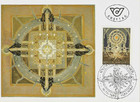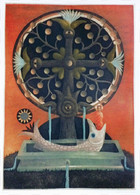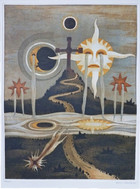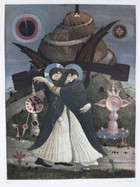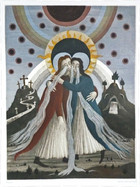Ernst Steiner
Viewing the works of Swiss-Austrian Symbolist Ernst Steiner in the Sacred Art Pilgrim Collection is like journeying into the Jungian realm of the collective unconscious. The sun and the moon weep streams of water. Eclipsed heavenly bodies blaze in ominous slate-grey skies. Numinous figures, haloed and winged, embrace beside biomorphic time pieces and flowing fountains. Cypresses stand sentinel in sacred groves and tangled branches braid into cruciform Trees of Life. As Steiner once explained: “The Artist is Pontiff connecting the present with the beyond…a midwife for what wants to be revealed to the world.”
Born in Switzerland in 1935, Steiner moved to Austria in his twenties to study at the Academies of Fine Arts and Applied Arts in Vienna. Influenced by the works of Marc Chagall and Alfred Kubin, he rejected abstract modernist trends and and found artists of like mind in post-war Vienna's Fantastic Realism movement. Schooled in the painting of North European Masters like Hieronymus Bosch and Matthias Grunewald, the Viennese Fantastic Realists combine realistic motifs in enigmatic, non-rational ways but part company with the more automatist Surrealists in their conscious manipulation of detail to convey esoteric meanings.
Steiner is an ambidextrous artist who paints, makes prints, designs stage sets and postage stamps. He even writes books of “dream-tales.” His study of music theory has led him in recent years to create repetitive, mathematically precise, geometric designs, expressing the harmonies he believes undergird the universe. The first day cover in my collection of Steiner's 1989 cosmic clock stamp for the Austrian Post displays a tapestry where circles, squares, triangles and repeated crosses combine to create a labyrinthine image of the Heavenly Jerusalem.
The four untitled color etchings/aquatints in the Steiner image gallery, all dating from 1975, are rich in symbols of Christ’s Passion. Crosses often appear in the visionary artist’s work as Trees of Life, represented in one print as a circular espalier fruit tree. In the pool below a haloed man in orange, emerges from the mouth of a fish—the Resurrected Christ seen as the Second Jonah. In a second etching, a lone cross atop a hill is flanked by a weeping moon and sun, drawn from traditional Crucifixion imagery. Winding paths to Golgotha appear in two more prints of embracing figures, bringing to mind images of the Stations of the Cross—and the betrayal in Gethsemane.
